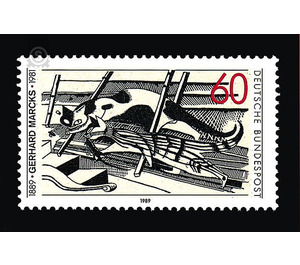100th birthday of GerhardMarcks - Germany / Federal Republic of Germany 1989 - 60 Pfennig
Theme: Animals
| Country | Germany / Federal Republic of Germany |
| Issue Date | 1989 |
| Face Value | 60.00 |
| Color | black grey |
| Perforation | K 14 |
| Printing Type | 4-color offset printing |
| Stamp Type | Postage stamp |
| Item Type | Stamp |
| Chronological Issue Number | 1283 |
| Chronological Chapter | GER-BRD |
| SID | 346911 |
| In 37 Wishlists | |
Gerhard Marcks, born in Berlin on 18 February 1889, is regarded as one of the most important representatives of figurative German sculpture in the 20th century, alongside Wilhelm Lehmbruck and Ernst Barlach. After his beginnings as an animal sculptor in the Berlin tradition of classicism, he soon found a connection to the - against historicism directed - renewal movement in sculpture, which owes its essential impetus to the French sculptor August Rodin. The early work, characterized by immediacy in the reproduction of nature observation and a painterly surface treatment, was abruptly interrupted by the First World War. As a seriously ill Marcks returns back in 1915. In 1919, Walter Gropius, the founder of the State Bauhaus in Weimar, entrusted him with the direction of the Bauhaus pottery in Dornburg. The figures and reliefs made of wood and terracotta, rarely of metal, which marks Marcks as a Bauhaus master next to ceramics, are characterized by the search for elemental, "pure" forms and plastic signs; they clearly show the influence of Expressionist ideas and the examination of the art of the Middle Ages as well as the cultures of primitive peoples. Within his extensive printmaking work, these years until 1925 are probably his most significant period of work. Inspired by Lyonel Feininger, he captures the landscape, genre scenes and the farming world in woodcuts. In 1921 the woodcut "Cats in the attic", which is particularly characteristic of his design elements, is created. In 1925, Marcks became the head of the sculpture class at the Kunstgewerbeschule Burg Giebichenstein near Halle / Saale. For the first time heavy, elementary, cubic stone figures of great intensity and expressiveness as well as monumental bronzes are created. Decisive for his changed conception of figurativeness is his first trip to Greece from 1928 (Villa Romana Prize). It becomes a key experience for all his further work, from which no academic classicism emerges, but a living, yet serene, and essentially condensed interpretation of nature. Marcks receives wide recognition, but is released in 1933 by the National Socialists; some works can be seen at the exhibition "Degenerate Art" from 1939 in Munich. With his wife and five children, he lives in seclusion in Nienhagen / Baltic Sea, from 1937 also back in Berlin. Exhibition disabilities and bans threaten its existence. In 1943 the eldest son falls, the house and studio in Berlin are bombed. Numerous outsourced works are destroyed in 1945. After the war, Marcks took over a professorship at the Landeskunstschule in Hamburg for a few years, until in 1950 he finally settled in Cologne-Müngersdorf. Almost sixty, he begins again to build a new plant. As one of the great old masters of figurative sculpture, he is overwhelmed with public contracts. Above all, he is one of the most important creators of the central reminder and memorial times for the victims of the war and the National Socialist tyranny: Only the memorial sites in Hamburg-Ohlsdorf, Cologne, Mannheim, Bochum and Osnabrück are mentioned. The preservation of the image of man remains despite him, or rather because of the experience of two world wars supreme postulate. Marcks is honored by numerous exhibitions, prizes and awards (inter alia, Order Pour le mérite 1952, Great Art Award of the State of North Rhine-Westphalia 1954, Grand Cross of Merit 1959, Grand Cross of Merit with star and shoulder strap 1964). The recognition applies not only to his sculptural work but also to his graphic work; the draftsman Marcks is equivalent to see next to the sculptor. In 1971, during his lifetime, a foundation was set up in Bremen that looked after his artistic heritage and made it accessible in an exhibition building (Gerhard Marcks House). On November 13, 1981, Gerhard Marcks dies in Burgbrohl / Eifel. (Text: Gerhard Marcks Foundation, Bremen)


